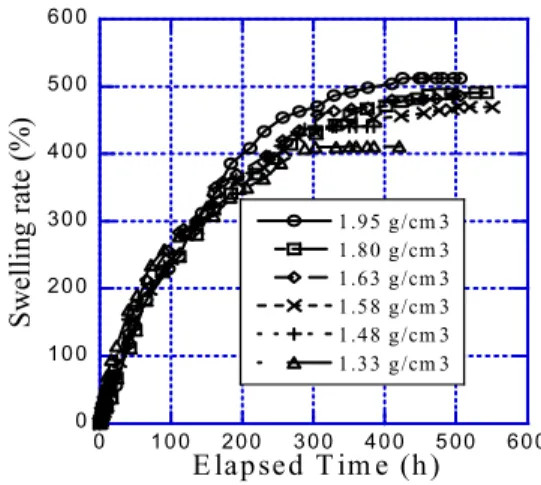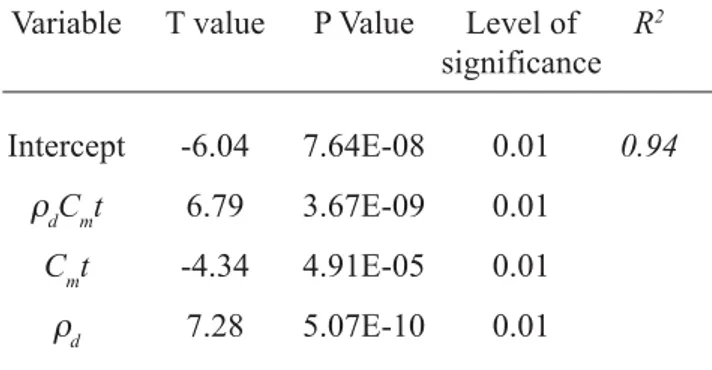The Influence of Temperature on Swelling Characteristics of Compacted Bentonite
for Waste Disposal
Sharif Moniruzzaman Shirazi a, Hidehiko Kazama b, Jiro Kuwano b and Mohammad Mamunur Rashid c
a Senior Lecturer, Dept. of Civil Engineering, University of Malaya, 50603 Kuala Lumpur, Malaysia, and Researcher,
GRIS, Saitama University, 255 Shimo-okubo, Sakura-ku, Saitama-shi, 338-8570 Japan
b Professor, GRIS, Saitama University, 255 Shimo-okubo, Sakura-ku, Saitama-shi, 338-8570 Japan
c Graduate Student, Saitama University, 255 Shimo-okubo, Sakura-ku, Saitama-shi, 338-8570 Japan
Abstract
A series of experiment was conducted to find out the temperature effect on swelling characteristics of compacted bentonite. The expansion of partly saturated bentonite affects the volume change of air in the specimen respect to initial dry density. Swelling pressure reaches nearly maximum when degree of saturation of specimen is about 95% for all initial dry densities (1.29 ~ 1.95 g/cm3) in swelling pressure test using temperature 20 ~ 80°C. Initial dry density and temperature
are the governing parameter to control the swelling pressure and deformation of compacted bentonite. To predict the swelling pressure an equation has been proposed in relation to content of montmorillonite, temperature and initial dry density of bentonite. The maximum difference between the experimental values and the fitting of this equation is 15% on an average.
Keywords: Bentonite; temperature; swelling characteristics; waste disposal
1. Introduction
Design of repositories for radioactive waste disposal in deep underground leads to the necessity of compacted bentonite characteristics subjected to thermal changes. Bentonite has good sorption properties, micro-porous structure, low hydraulic conductivity and plasticity to act as an effective barrier and restricting the movement of nuclides from the waste packages after canister failure. These important properties could be lost by thermally induced effects that might arise from the decay heat released from the waste. Temperature changes affect important hydraulic characteristics, swelling pressure, swelling and collapse behavior (Sultan et al., 2002; Onal, 2007; Perronnet et al., 2008). Compacted buffer material played a key role preventing the vitrified waste from the early stages when the radioactivity levels and temperatures due to the radiogenic heat production of the waste are high. To ensure the long term safety of geological disposal, a basic requirement on the buffer is to restrict radionuclide migration from breached waste packages to the surrounding host rock. The buffer material also effectively filters any possible radionuclide bearing colloids that might from radioactive waste (Sato, 2001;
the use of compacted bentonite in barrier systems has been adopted in different countries of the world. Available information regarding temperature effect on swelling characteristics of compacted bentonite is very few. Therefore, there remains a challenge to scientists and researchers to thoroughly understand the swelling behavior by temperature and density of compacted bentonite.
2. Materials and Specimen Making Methods
Two types of powdered bentonite (Super clay and Kunigel) were used in this investigation. The specific gravity, initial water content, liquid limit, plastic limit, plasticity index and grain size of different types of bentonite are presented in Table 1. The percentage of fine particle is higher in super clay compared to Kunigel so that the liquid limit also higher in super clay. A compaction device (Model No.CLP-200 KNB) was used for compaction of the specimen to attain requisite density of bentonite for this study. Compaction pressure (7 ~ 70 MPa) were applied to get a broad range of dry densities of compacted bentonite 1.29 ~ 1.95 g/cm3. The diameter and height of the specimens were 6 cm and 1 cm, respectively. Content of montmorillonite of
2.1. Swelling deformation
Free swelling test of compacted bentonite (1.33 ~ 1.95 g/cm3) were carried out to study the swelling behavior of the specimens. Filter papers and porous plates are installed at the top and bottom of the specimen surfaces and distilled water is supplied from a burette to the base of mould. Time is recorded when water supply initiates to the specimen. Water uptake of specimens is measured to understand the volume change of compacted bentonite under no loading condition. The specimen deformation is measured by dial gauge which minimum value is 0.01mm and experiment is stopped when deformation is nearly equilibrium.
Table 1. Index properties of bentonite
Properties Kunigel Super clay
Specific gravity Gs 2.797 2.857
Initial water content W0 (%) 7.20 10.10
Liquid limit WL (%) 497 690
Plastic limit WP (%) 26 43
Plasticity index IP 471 647
0.075~2 mm 0 0
Grain size 0.005~0.75 mm 25 13
<0.005 mm 75 87
Figure 1. Free swelling rate of Kunigel
2.2. Swell pressure
Swelling pressures were directly measured from digital strain meter in swelling pressure test in which the volume of specimen was kept constant. Swelling pressure test has been carried out in a range of temperature 20 ~ 80°C in the incubator by controlled temperature and humidity. Two porous stones are covered top and bottom surfaces of the specimens and the supply water drained through the bottom porous stone. The relationship between swelling pressure and the time required from the start of distilled water supply is measured. After experimental work, degree of saturation of the specimens was measured about 100%.
0 50 100 150 200
0 100 200 300 400 500 600
Total V olum e
V ol. of (W ater + Bentonite) V olume of Bentonite
Vo
lum
e (cm
3 )
Elapsed time (h)
Benton ite W ater A ir
0 1 0 0 2 0 0 3 0 0 4 0 0 5 0 0 6 0 0
0 1 0 0 2 0 0 3 0 0 4 0 0 5 0 0 6 0 0
1 .9 5 g /cm 3 1 .8 0 g /cm 3 1 .6 3 g /cm 3 1 .5 8 g /cm 3 1 .4 8 g /cm 3 1 .3 3 g /cm 3
Sw
elling
rate
(%
)
E la p sed T im e (h )
3. Results and Discussion
The relationship between swelling rate and elapsed time for various initial dry densities are shown in Fig. 1. The percent swelling is defined as the change in the axial height of the sample relative to the initial height. Volume changes of air and water in the specimen during free swelling process of compacted bentonite are presented in Fig. 2. At initial stage of swelling deformation test water intake rate of lower density specimens were higher compared to higher density specimen due to different void ratio. The volume of water entered into the specimen was observed by the water head variation of burette.
Fig. 3 shows the relationship between swelling pressure and elapsed time for super clay bentonite at temperature 80°C. This study found temperature is another key parameter which influences the swelling pressure of bentonite. At constant temperature swelling pressure did not fluctuate with elapsed time while Shirazi and Kazama (2004) and Shirazi et al. (2008)
0 2 4 6 8 10
0 10 20 30 40 50
1.90 g/cm 3 1.79 g/cm 3 1.65 g/cm 3 1.59 g/cm 3 1.48 g/cm 3 1.40 g/cm 3 1.29 g/cm 3
Sw
el
li
ng
p
re
ss
u
re
(M
Pa
)
E lapsed tim e (h)
0 2 4 6 8 10
0 20 40 60 80 100 120
1.90 g/cm 3 1.79 g/cm 3 1.65 g/cm 3 1.59 g/cm 3 1.48 g/cm 3 1.40 g/cm 3 1.29 g/cm 3
Sw
el
li
n
g
p
re
ss
u
re
(
M
P
a)
Degree of saturation (% )
Figure 4. Relationship between degree of saturation and swelling pressure of Superclay at 45°C
Figure 3. Swelling pressure of Superclay at 80°C
observed that swelling pressure fluctuated by temperature fluctuation. Swelling pressure is reached nearly maximum when degree of saturation is about 95% (Fig. 4). Due to temperature, degree of saturation influences the moisture migration into the montmorillonite structure and resulted in swell pressure. Relationship between temperature and maximum swelling pressure at different initial dry density of compacted bentonite are presented in Fig. 5 and 6. Swelling pressure linearly increased with temperature. At the same temperature and initial dry density of compacted bentonite super clay exhibited higher swelling pressure compared to kunigel due to percent of montmorillonite content. At different temperature maximum swelling pressure increased linearly based on the initial dry density of compacted bentonite (Figs. 7-8). R2 values of those equations are
expressed the strong linear correlation between initial dry density and swelling pressure. But exponential correlation was observed by Shirazi et al. (2006) and Komine and Ogata (1999).
Figure 5. Relationship between temperature and swelling pressure of Kunigel
0 2 4 6 8 10
0 2 4 6 8 10
All Specimen 45 Line +15 % line -15% line
E
sti
m
ated
s
w
el
li
n
g pr
es
su
re
(M
Pa
)
M easured swelling pressure (M Pa)
A multiple regression analysis including all experimental data gave the following correlation:
---(1)
Where Sp = swelling pressure, ρd = initial dry density, Cm = content of montmorillonite and t = temperature (°C). The swelling pressures predicted by Eq. (1) were compared with the direct measurements from the incubator swelling pressure tests, as shown in Fig. 9. Table 2 summarizes the regression analysis results.
Table 2. Analysis of variance (ANOVA)
Figure 7. Relationship between swelling pressure and initial dry density of Superclay at different temperature
Figure 8. Relationship between swelling pressure and initial dry density of Kunigel at different temperature
4. Conclusions
Temperature and initial dry density of compacted bentonite is the important factor to influence the swelling behavior. Free swelling rate increased with initial dry density and content of montmorillonite. Swelling pressure as a linear function of temperature is observed. It is necessary to have simple relationships of bentonite density, temperature and swelling pressure. A regression equation is developed from the experimental data to estimate maximum swell pressure of compacted bentonite given by the dry density, temperature and content of montmorillonite.
Figure 9. Comparison of measured/predicted swelling pressure of all specimen
2
0.11 0.12 4.57 6.14 0.94
p d m m d
S C t C t
R
U U
Variable T value P Value Level of R2
significance
Intercept -6.04 7.64E-08 0.01 0.94
ρdCmt 6.79 3.67E-09 0.01
Cmt -4.34 4.91E-05 0.01
Acknowledgements
Financial support by the Japan Society for the Promotion of Science (JSPS) is gratefully acknowledged. Helpful comments of the referees are greatly appreciated, which significantly improved the quality of original manuscript. Thanks are due to Mr. Mayo Thant for helping laboratory experiment.
References
Komine H, Ogata N. Experimental study on swelling characteristics of sand-bentonite mixture for nuclear waste disposal, Soils and Foundations, 1999, 39 (2): 83-97.
Onal M. Swelling and cation exchange capacity relationship for the samples obtained from a bentonite by acid activations and heat treatments, Applied Clay Science, 2007, 37: 74-80.
Perronnet M, Jullien M, Villieras F, Raynal J, Bonnin D, Bruno G. Evidence of critical content in Fe(O) on FoCa7 bentonite reactivity at 80°C, Applied Clay Science, 2008, 38: 187-202.
Sato T, Okada T, Iida Y, Yamaguchi T, Nakayama S. Observation of pore generation due to interaction between bentonite and high pH solution, Clay science for engineering, A.A. Balkema, P.O. Box 1675, 3000 BR Rotterdam, Netherlands, 2001, 593-98.
Shang JQ, Lo KY, Quigley RM. Quantitative determination of potential distribution in Stern-Gouy double layer model, Canadian Geotechnical Journal, 1994, 31: 624-36.
Shirazi SM, Kazama H. Swelling properties of bentonite and bentonite-sand mixture for nuclear waste disposal. Australian Geomechanics, 2004, 39 (4): 71-79.
Shirazi SM, Kazama H, Chim-oye W. Temperature and density effect on swelling characteristics and permeability of bentonite. AustralianGeomechanics, 2006, 41 (2): 89-100.
Shirazi SM, Kazama H, Chim-oye W and Kuwano J. Effect of void ratio on swelling and permeability of bentonite. AustralianGeomechanics, 2008, 43(2): 9-19.
Sultan N, Delage P, Cui YJ. Temperature effects on the volume change behavior of Boom clay. Engineering Geology, 2002, 64: 135-45.
Received 18 April 2010 Accepted 3 June 2010
Correspondence to
Dr. Sharif Moniruzzaman Shirazi Department of Civil Engineering University of Malaya
50603 Kuala Lumpur Malaysia
or
Saitama University
Geosphere Research Institute 255 Shimo-okubo, Sakura-Ku, Saitama-shi 338-8570, Japan


